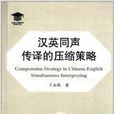《北京第2外國語學院博士學術文庫:漢英同聲傳譯的壓縮策略》語料豐富了契諾夫對同聲傳譯壓縮現象的分類並拓展了同聲傳譯壓縮現象的研究。同聲傳譯壓縮現象的主要因素是語言的冗餘成分、口語話語特點、講話語境、漢英語言句法和文化差異等。同聲傳譯的具體話語語篇、譯員的職業經驗和技能以及譯員的思維與表達速度均會影響壓縮策略的套用。
基本介紹
- 書名:漢英同聲傳譯的壓縮策略
- 作者:王永秋
- 出版日期:2010年8月1日
- 語種:簡體中文, 英語
- ISBN:9787560098609
- 外文名:Compression Strategy in Chinese-English Simultaneous Interpreting
- 出版社:外語教學與研究出版社
- 頁數:365頁
- 開本:32
內容簡介,圖書目錄,
內容簡介
《北京第2外國語學院博士學術文庫:漢英同聲傳譯的壓縮策略》由外語教學與研究出版社出版。
圖書目錄
Abstract
Acknowledgements
Abbreviations Used in This Book
Chapter One: Introduction
1.1 Background of the Study
1.2 Aims of the Study
1.3 Research Questions and Hypotheses
1.4 Theoretical Foundations
1.4.1 Linguistic Theories
1.4.2 Translation Theories
1.5 Some Related Terms Defined
1.6 The Structure of This Book
Chapter Two: Review of Literature
2.1 SI as a Profession
2.2 Quality Assessment in Interpreting
2.3 Compression in Interpreting
2.4 Omission in Interpreting
2.5 Strategy in Interpreting
Chapter Three: Research Methods
3.1 The Data
3.2 Research Methods
3.3 Notes on Transcripts
3.4 An Example of Analysis in the Findings
Chapter Four: Findings
4.1 Syllabic Compression
4.1.1 Substituting an Abbreviation or Acronym for theFull Name or a Phrase
4.1.2 Substituting a Pronoun for a Noun Phrase
4.1.3 Substituting a Noun for a Noun Phrase
4.2 Lexical Compression
4.2.1 Omission of Expressions of Public Opinions
4.2.2 Omission of Expressions of Speakers' Personal Views
4.2.3 Omission of Expressions of Speakers' Personal Habits
4.2.4 Omission of Transitional Words
4.3 Syntactic Compression
4.3.1 Breaking a Complex or Compound Sentence intoSimple Sentences
4.3.2 Compressing Two or More Simple Sentences, Complex
Sentences or Compound Sentences into One Simple or
Complex Sentence
4.3.3 Omission of Appositives
4.3.4 Substituting a Prepositional Phrase for a Sentence
4.3.5 Substituting an Infinitive Phrase for a Clause
4.3.6 Substituting Sentence Fragment for a Sentence
4.4 Semantic Compression
4.4.1 Deletion of Iterative Semantic Components
4.4.2 Reduction of Unimportant Semantic Components
4.4.3 Reduction of Self—Extracting Expressions fromDiscourse Inferences
4.4.4 Substituting General Words for Specific Words
4.4.5 Substituting Shorter Expressions for Longer Expressions
4.4.6 Semantic Paraphrase
4.5 Situational Compression
4.5.1 Omission of Components Related to the LegCo
4.5.2 Omission of Expressions of Asking Questions
4.5.3 Omission of Polite Forms of Address
4.5.4 Omission of Formality Expressions
4.6 Pragmatic Compression
Chapter Five: Factors of Compression and Implications ofThis Study
5.1 The Nature of Compression
5.2 Factors of Compression and Interpreters' Views onCompression
5.3 Compression and Quality Assessment
5.4 Practical and Didactic Implications
Chapter Six: Conclusion
6.1 A Summary of the Findings
6.2 Contributions of the Present Study
6.3 Limitations of the Present Investigation
6.4 Recommendations for Future Research
Appendice
Appendix 1.Transcripts of ST of the Meeting on 9 Jan.2003
Appendix 2.Transcripts ofSI (TT) of the Meeting on 9 Jan.2003
Appendix 3.Transcripts of ST of the Meeting on 13 Oct.2005
Appendix 4.Transcripts ofSI (TT) of the Meeting on 13 Oct.2005
Appendix 5.Transcripts of ST of the Meeting on 12 Oct.2006
Appendix 6.Transcripts ofSI (TT) of the Meeting on 12 Oct.2006
Appendix 7.Questionnaire for Interpreters
References
Acknowledgements
Abbreviations Used in This Book
Chapter One: Introduction
1.1 Background of the Study
1.2 Aims of the Study
1.3 Research Questions and Hypotheses
1.4 Theoretical Foundations
1.4.1 Linguistic Theories
1.4.2 Translation Theories
1.5 Some Related Terms Defined
1.6 The Structure of This Book
Chapter Two: Review of Literature
2.1 SI as a Profession
2.2 Quality Assessment in Interpreting
2.3 Compression in Interpreting
2.4 Omission in Interpreting
2.5 Strategy in Interpreting
Chapter Three: Research Methods
3.1 The Data
3.2 Research Methods
3.3 Notes on Transcripts
3.4 An Example of Analysis in the Findings
Chapter Four: Findings
4.1 Syllabic Compression
4.1.1 Substituting an Abbreviation or Acronym for theFull Name or a Phrase
4.1.2 Substituting a Pronoun for a Noun Phrase
4.1.3 Substituting a Noun for a Noun Phrase
4.2 Lexical Compression
4.2.1 Omission of Expressions of Public Opinions
4.2.2 Omission of Expressions of Speakers' Personal Views
4.2.3 Omission of Expressions of Speakers' Personal Habits
4.2.4 Omission of Transitional Words
4.3 Syntactic Compression
4.3.1 Breaking a Complex or Compound Sentence intoSimple Sentences
4.3.2 Compressing Two or More Simple Sentences, Complex
Sentences or Compound Sentences into One Simple or
Complex Sentence
4.3.3 Omission of Appositives
4.3.4 Substituting a Prepositional Phrase for a Sentence
4.3.5 Substituting an Infinitive Phrase for a Clause
4.3.6 Substituting Sentence Fragment for a Sentence
4.4 Semantic Compression
4.4.1 Deletion of Iterative Semantic Components
4.4.2 Reduction of Unimportant Semantic Components
4.4.3 Reduction of Self—Extracting Expressions fromDiscourse Inferences
4.4.4 Substituting General Words for Specific Words
4.4.5 Substituting Shorter Expressions for Longer Expressions
4.4.6 Semantic Paraphrase
4.5 Situational Compression
4.5.1 Omission of Components Related to the LegCo
4.5.2 Omission of Expressions of Asking Questions
4.5.3 Omission of Polite Forms of Address
4.5.4 Omission of Formality Expressions
4.6 Pragmatic Compression
Chapter Five: Factors of Compression and Implications ofThis Study
5.1 The Nature of Compression
5.2 Factors of Compression and Interpreters' Views onCompression
5.3 Compression and Quality Assessment
5.4 Practical and Didactic Implications
Chapter Six: Conclusion
6.1 A Summary of the Findings
6.2 Contributions of the Present Study
6.3 Limitations of the Present Investigation
6.4 Recommendations for Future Research
Appendice
Appendix 1.Transcripts of ST of the Meeting on 9 Jan.2003
Appendix 2.Transcripts ofSI (TT) of the Meeting on 9 Jan.2003
Appendix 3.Transcripts of ST of the Meeting on 13 Oct.2005
Appendix 4.Transcripts ofSI (TT) of the Meeting on 13 Oct.2005
Appendix 5.Transcripts of ST of the Meeting on 12 Oct.2006
Appendix 6.Transcripts ofSI (TT) of the Meeting on 12 Oct.2006
Appendix 7.Questionnaire for Interpreters
References

